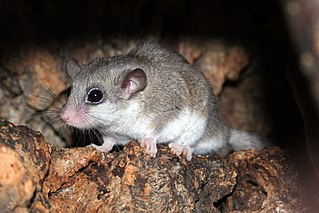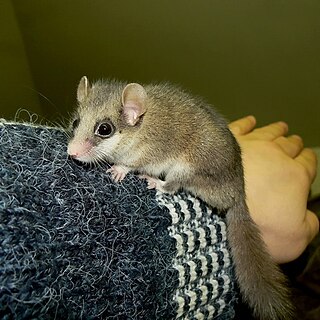
A dormouse is a rodent of the family Gliridae. Dormice are nocturnal animals found in Africa, Asia, and Europe. They are named for their long, dormant hibernation period of six months or longer.

The Europeanedible dormouse or European fat dormouse is a large dormouse and one of only two living species in the genus Glis, found in most of Europe and parts of western Asia. Its name comes from the Romans, who ate them as a delicacy.

The African dormice are dormice that live throughout sub-Saharan Africa in a variety of habitats. They are very agile climbers and have bushy tails. They eat invertebrates and small vertebrates.

The Asian garden dormouse or large-eared garden dormouse, is a species of rodent in the family Gliridae. It is found in Egypt, Iraq, Israel, Jordan, Lebanon, Libya, Saudi Arabia, Syria and Turkey. Its natural habitats are temperate forests, subtropical or tropical dry shrubland, Mediterranean-type shrubby vegetation, rocky areas and gardens.

The Japanese dormouse is a species of rodent in the family Gliridae endemic to Japan. It is the only extant species within the genus Glirulus. Its natural habitat is temperate forests. In Japanese, it is called yamane. Among dormice, it has the special ability of running at great speed upside down, suspended from branches. Its main food is fruit, insects, berries, nuts, and even flowers. It tends to inhabit arboreal nesting sites to avoid interspecific competition with the small Japanese field mouse because of their sympatric relationship.
The Angolan African dormouse is a species of rodent in the family Gliridae. Found in central and north Angola and western Zambia, it has been recorded from seven localities over an altitudinal range from 1,000 to 2,000 m above sea level. Its natural habitat is tropical dry forests. Although the population size is unknown, it is thought to be generally uncommon.
Christy's dormouse is a species of rodent in the family Gliridae. It is found in Cameroon and Democratic Republic of the Congo. Its natural habitat is subtropical or tropical moist lowland forests.
Jentink's dormouse is a species of rodent in the family Gliridae. It is found in Cameroon, Ivory Coast, Ghana, Liberia, Nigeria, and Togo, and possibly Benin, Equatorial Guinea, and Sierra Leone. Its natural habitat is subtropical or tropical, moist lowland forests.
The Johnston's African dormouse is a species of rodent in the family Gliridae. It is found in Malawi, Zambia, and Zimbabwe. Its natural habitat is moist savanna.
Kellen's dormouse is a species of rodent in the family Gliridae. It is native to tropical Africa where its range extends from the Gambia and Senegal to Kenya and Tanzania. Its natural habitats are subtropical or tropical dry forests, and moist or dry savannah.
The Lorrain dormouse is a species of rodent in the family Gliridae. It is found in Cameroon, Democratic Republic of the Congo, Ghana, Guinea-Bissau, Liberia, Nigeria, Sierra Leone, Tanzania, and Uganda. Its natural habitats are subtropical or tropical, moist, lowland forests, moist savanna, and plantations.
The small-eared dormouse is a species of rodent in the family Gliridae. It is found in Angola, Botswana, Eritrea, Ethiopia, Kenya, Lesotho, Malawi, Mozambique, Namibia, South Africa, Sudan, Eswatini, Tanzania, Zambia, and Zimbabwe.
Monard's dormouse is a species of rodent in the family Gliridae. It is found in Angola, Democratic Republic of the Congo, and possibly Zambia. Its natural habitat is moist Central Zambezian miombo woodlands savanna.

The woodland dormouse is a species of rodent in the family Gliridae. It is native to southern and eastern Africa and is also known as the African dormouse, African dwarf dormouse, African pygmy dormouse, or colloquially as micro squirrel. Found in limited numbers in the pet trade, it has complicated care requirements compared to other pet rodents. Its natural habitats are subtropical or tropical, moist montane forests and rivers.
The Nagtglas's African dormouse is a species of rodent in the family Gliridae. It is found in Cameroon, Central African Republic, Ghana, Liberia, Nigeria, Sierra Leone, and possibly Gabon. Its natural habitat is subtropical or tropical, moist, lowland forests. The rodent is named after Cornelis Nagtglas.

The spectacled dormouse or namtap is a species of rodent in the family Gliridae, and one of four dormouse species endemic to South Africa.
The rock dormouse or flat-headed African dormouse is a species of rodent in the family Gliridae. It is found in Botswana, Mozambique, South Africa, Eswatini, Zambia, and Zimbabwe where it lives among rocks in upland areas. It is a fairly common, mainly nocturnal species and the International Union for Conservation of Nature has assessed its conservation status as being of "least concern".
The stone dormouse is a species of rodent in the family Gliridae. It is found in Namibia, South Africa, and possibly Angola. Its natural habitat is rocky areas in the Karoo. Though it has a limited range, it is a fairly common species and the International Union for Conservation of Nature has assessed its conservation status as being of "least concern".
The silent dormouse is a species of rodent in the family Gliridae. It is found in Cameroon, Democratic Republic of the Congo, Equatorial Guinea, and Gabon. Its natural habitat is subtropical or tropical moist lowland forests.

The Roach's mouse-tailed dormouse or ground dormouse, also known simply as the mouse-tailed dormouse, is a species of rodent in the family Gliridae. It is found in Bulgaria, Turkey, and possibly the far east of Greece.







